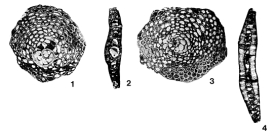Foraminifera taxon details
Eulinderina Barker & Grimsdale, 1936 †
722306 (urn:lsid:marinespecies.org:taxname:722306)
accepted
Genus
Planorbulina (Planorbulinella) guayabalensis Nuttall, 1930 † accepted as Eulinderina guayabalensis (Nuttall, 1930) † (type by original designation)
- Species Eulinderina guayabalensis (Nuttall, 1930) †
- Species Eulinderina regularis Barker & Grimsdale, 1936 †
- Subgenus Eulinderina (Eolepidina) Tan, 1939 † accepted as Eolepidina Tan, 1939 † (Nomen translatum)
- Species Eulinderina antillea (Cushman, 1919) † accepted as Eolepidina antillea (Cushman, 1919) † (unaccepted > superseded combination)
- Species Eulinderina semiradiata Barker & Grimsdale, 1936 † accepted as Eolepidina semiradiata (Barker & Grimsdale, 1936) † accepted as Eolepidina antillea (Cushman, 1919) † (unaccepted > superseded combination, Type species of Eolepidina)
marine, brackish, fresh, terrestrial
fossil only
feminine
Barker, R. W.; Grimsdale, T. F. (1936). A contribution to the phylogeny of the orbitoidal foraminifera, with descriptions of new forms from the Eocene of Mexico. <em>Journal of Paleontology.</em> 10: 231-247.
page(s): p. 237 [details] Available for editors [request]
[request]
page(s): p. 237 [details] Available for editors
Diagnosis Test lenticular to discoidal, bilocular embryonic stage followed by trochoid coil of one whorl with thick outer wall and...
Diagnosis Test lenticular to discoidal, bilocular embryonic stage followed by trochoid coil of one whorl with thick outer wall and few chambers, connected by apertures and countersepta, spire followed by a median layer of numerous cycles of arcuate chambers that are connected by cylindrical stolons, lateral wall layers may be in contact or may leave irregular interspaces that in some species become lateral chambers; wall calcareous, surface with large pustules representing the ends of pillars. M. Eocene; Mexico. (Loeblich & Tappan, 1987, Foraminiferal Genera and Their Classification) [details]
Hayward, B.W.; Le Coze, F.; Vachard, D.; Gross, O. (2025). World Foraminifera Database. Eulinderina Barker & Grimsdale, 1936 †. Accessed at: https://www.marinespecies.org/foraminifera/aphia.php?p=taxdetails&id=722306 on 2025-05-13
Date
action
by
original description
Barker, R. W.; Grimsdale, T. F. (1936). A contribution to the phylogeny of the orbitoidal foraminifera, with descriptions of new forms from the Eocene of Mexico. <em>Journal of Paleontology.</em> 10: 231-247.
page(s): p. 237 [details] Available for editors [request]
[request]
basis of record Loeblich, A. R.; Tappan, H. (1987). Foraminiferal Genera and their Classification. Van Nostrand Reinhold Company, New York. 970pp., available online at https://books.google.pt/books?id=n_BqCQAAQBAJ [details] Available for editors [request]
[request]
status source Mitchell, S. F.; Robinson, E.; Özcan, E.; Jiang, M. M.; Robinson, N. (2022). A larger benthic foraminiferal zonation for the Eocene of the Caribbean and central American region. <em>Carnets de géologie (Notebooks on geology).</em> 22(11): 409-566., available online at http://paleopolis.rediris.es/cg/22/11/CG2211.pdf [details] Available for editors [request]
[request]
page(s): p. 237 [details] Available for editors
basis of record Loeblich, A. R.; Tappan, H. (1987). Foraminiferal Genera and their Classification. Van Nostrand Reinhold Company, New York. 970pp., available online at https://books.google.pt/books?id=n_BqCQAAQBAJ [details] Available for editors
status source Mitchell, S. F.; Robinson, E.; Özcan, E.; Jiang, M. M.; Robinson, N. (2022). A larger benthic foraminiferal zonation for the Eocene of the Caribbean and central American region. <em>Carnets de géologie (Notebooks on geology).</em> 22(11): 409-566., available online at http://paleopolis.rediris.es/cg/22/11/CG2211.pdf [details] Available for editors
From editor or global species database
Diagnosis Test lenticular to discoidal, bilocular embryonic stage followed by trochoid coil of one whorl with thick outer wall and few chambers, connected by apertures and countersepta, spire followed by a median layer of numerous cycles of arcuate chambers that are connected by cylindrical stolons, lateral wall layers may be in contact or may leave irregular interspaces that in some species become lateral chambers; wall calcareous, surface with large pustules representing the ends of pillars. M. Eocene; Mexico. (Loeblich & Tappan, 1987, Foraminiferal Genera and Their Classification) [details]

